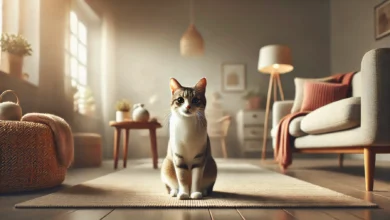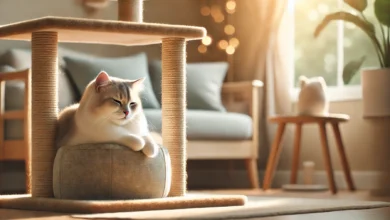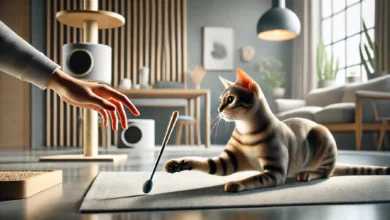How to Start Clicker Training for Cats
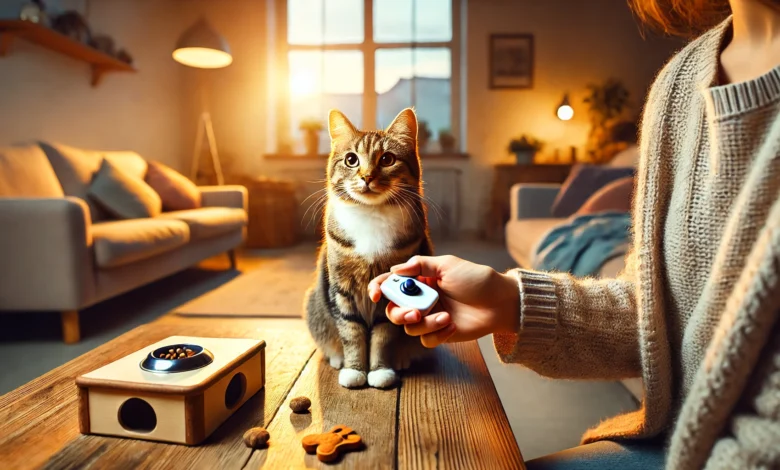
Clicker training is a fun and effective way of teaching tricks and behaviors to your cat.
Cats are different from dogs because they are usually perceived to be independent animals, and they can be somewhat less easily trainable.
But, with the proper approach, clicker training is really effective for communicating with your cat.
Whether it’s teaching your cat simple commands, encouraging good behavior, or even cementing your bond, clicker training is arguably one of the best tools you could have in your cat training repertoire.
In this article, we will walk you through everything you need to know to get started with clicker training for cats.
Table of Contents
What is Clicker Training for Cats?
Clicker training is a method of positive reinforcement that uses a small device called a clicker to mark desirable behaviors in your cat.
Every time your cat does something you want to encourage, you click the device and immediately give your cat a treat or attention.
The sound of the click acts as a clear indicator to the cat that they have done something right, making it easier for them to connect the action with a reward.
While clicker training has been widely used for dogs, it works just as well for cats.
The beauty of clicker training is that it relies on positive reinforcement, which is scientifically proven to be much more effective than punishment-based methods.
It helps your cat learn faster without creating fear or anxiety.
Eventually, your cat will associate the click with a reward, allowing you to shape and reinforce behaviors in a fun and engaging way for both you and your pet.
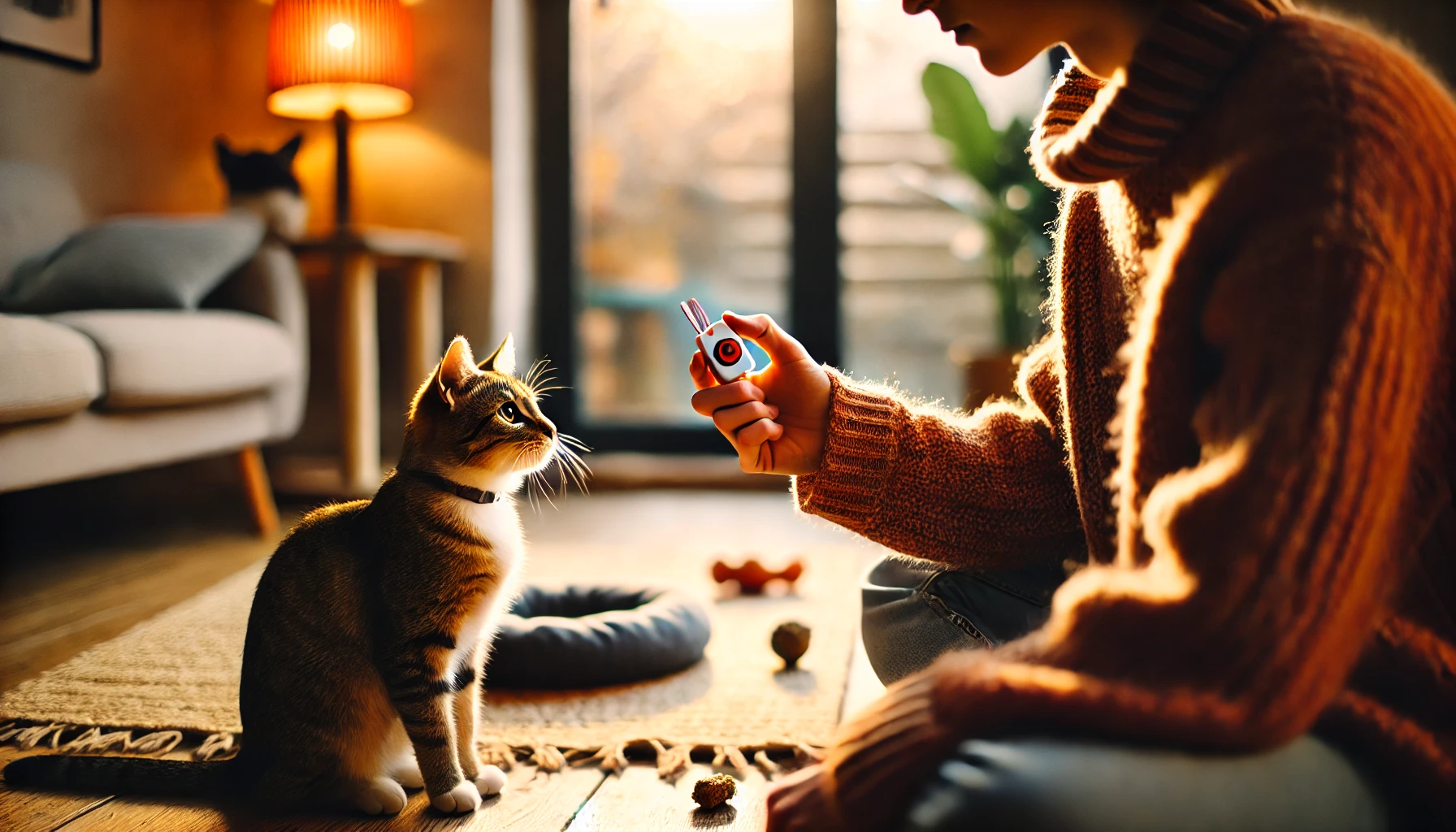
Understanding the Basics of Clicker Training
Success in clicker training depends on consistency.
Each time your cat engages in the desired behavior, you immediately click and reward them afterward.
The sound of the click is important because it tells the cat that they have done something right the moment the behavior occurs.
Timing is everything when it comes to clicker training.
You’ll need a clicker and some delicious treats for your kitty.
Begin by clicking the device and immediately giving your cat a treat.
This helps your cat understand that hearing the click means a reward is coming.
After several repetitions, your cat will start to associate the clicker with something positive.
- Click and reward consistently – Always click at the right moment when your cat performs the desired behavior, and immediately follow it up with a reward.
- Keep training sessions short – Cats can get bored or distracted easily, so aim for short sessions of 5-10 minutes, a few times a day.
- Be patient – Every cat is different. Some may learn quickly, while others may take time to get the hang of clicker training.
With time, patience, and plenty of treats, you’ll find that clicker training can become a highly rewarding experience for both you and your cat.
Clicker training is a proven method that utilizes positive reinforcement, making it easy for your cat to learn through rewards.
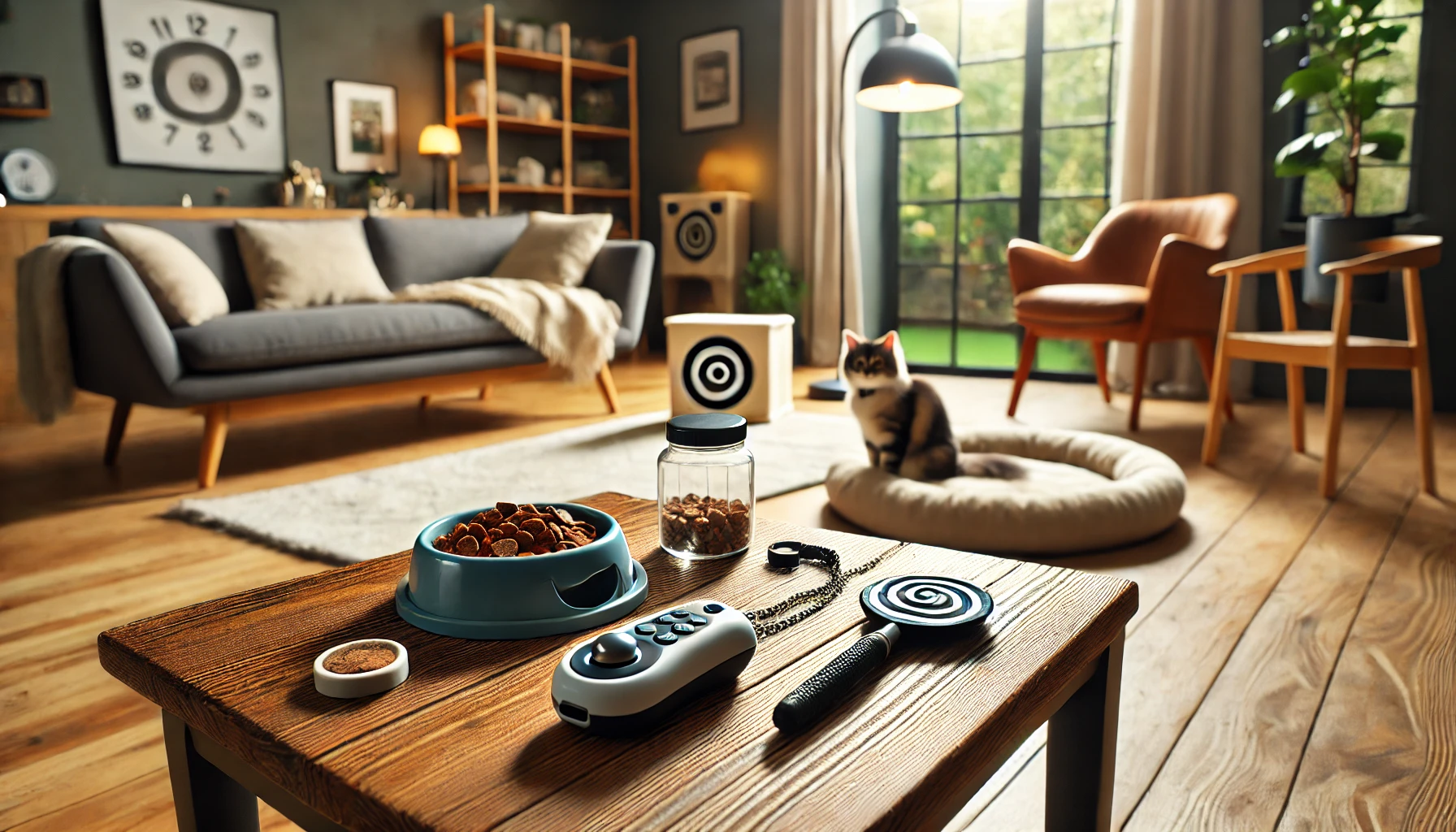
Preparing for Clicker Training: Equipment and Environment
Setting you and your cat up for success is one of the most important steps in clicker training.
Proper preparation will help your training sessions go smoothly, be pleasant, and productive.
In this section, we will cover the essential tools you will use and how to create a cat-friendly training environment.
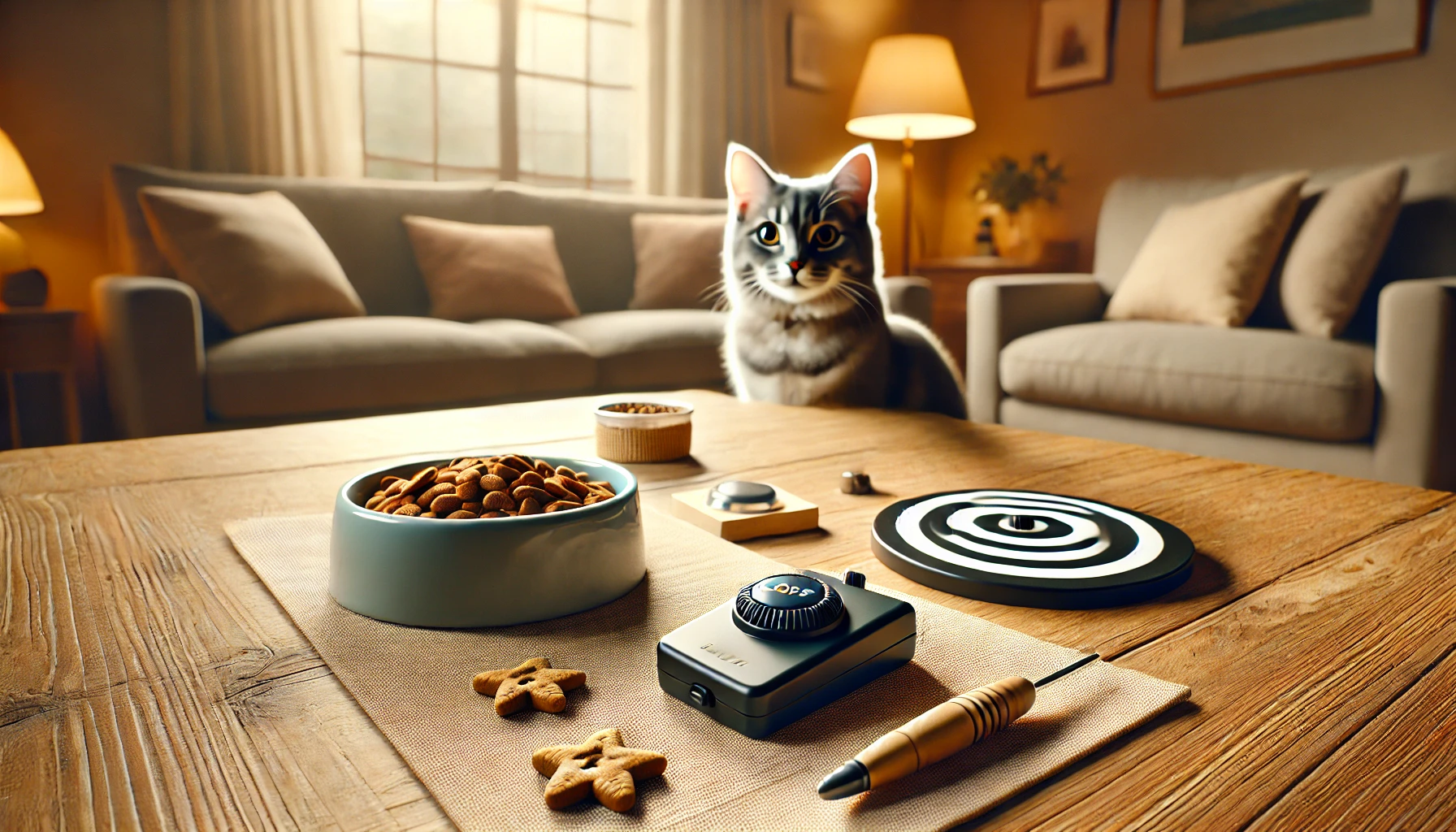
The Essentials You Will Be Needing
To get started with clicker training, you really don’t need a great deal of equipment, but a few essential tools will make things easier:
- Clicker – This small, handheld device makes a unique sound that your cat will learn to associate with completing the desired behavior. Clickers come in various shapes and sizes, but most pet owners prefer models that are easy to hold and click quickly.
- Treats – Treats are the most important part of clicker training, as they serve as the reward your cat will work for. Use small treats that your cat really likes and can quickly eat, as this will help keep them motivated. Try commercially available cat treats or small pieces of cooked chicken or tuna.
- Target Stick (optional) – You can use a target stick to teach your cat advanced behaviors, such as following or touching specific objects. While not essential for beginners, it can be helpful during more advanced training sessions.
Apart from these simple tools, your attention and patience will be the most important things you need during training sessions.

Setting Up a Training Environment That Your Cat Will Love
The environment in which you train your cat plays a significant role in the success or failure of your training sessions.
Cats are easily distracted or distressed by external stimuli, so it’s important to set up a peaceful, distraction-free area.
- Quiet Space – Select a quiet room with minimal disturbances where your cat feels comfortable. Loud noises or other pets could disrupt the training session or cause stress.
- Comfort Zone – Ensure the area is comfortable for your cat. Use a familiar room or space where they already spend a lot of time. The more comfortable they feel, the better they’ll focus on the training.
- Limited Distractions – Keep the area free of toys, food, or other pets that may distract your cat. A distracted cat is less likely to respond effectively to clicker training.
By creating an ideal setup with the right tools and a proper environment, you can help your cat learn and respond to the clicker more effectively.
Taking the time to prepare properly will ensure that the learning process goes smoothly and leads to successful clicker training.
Proper preparation ensures a smooth training process by setting up the right tools and environment for your cat.
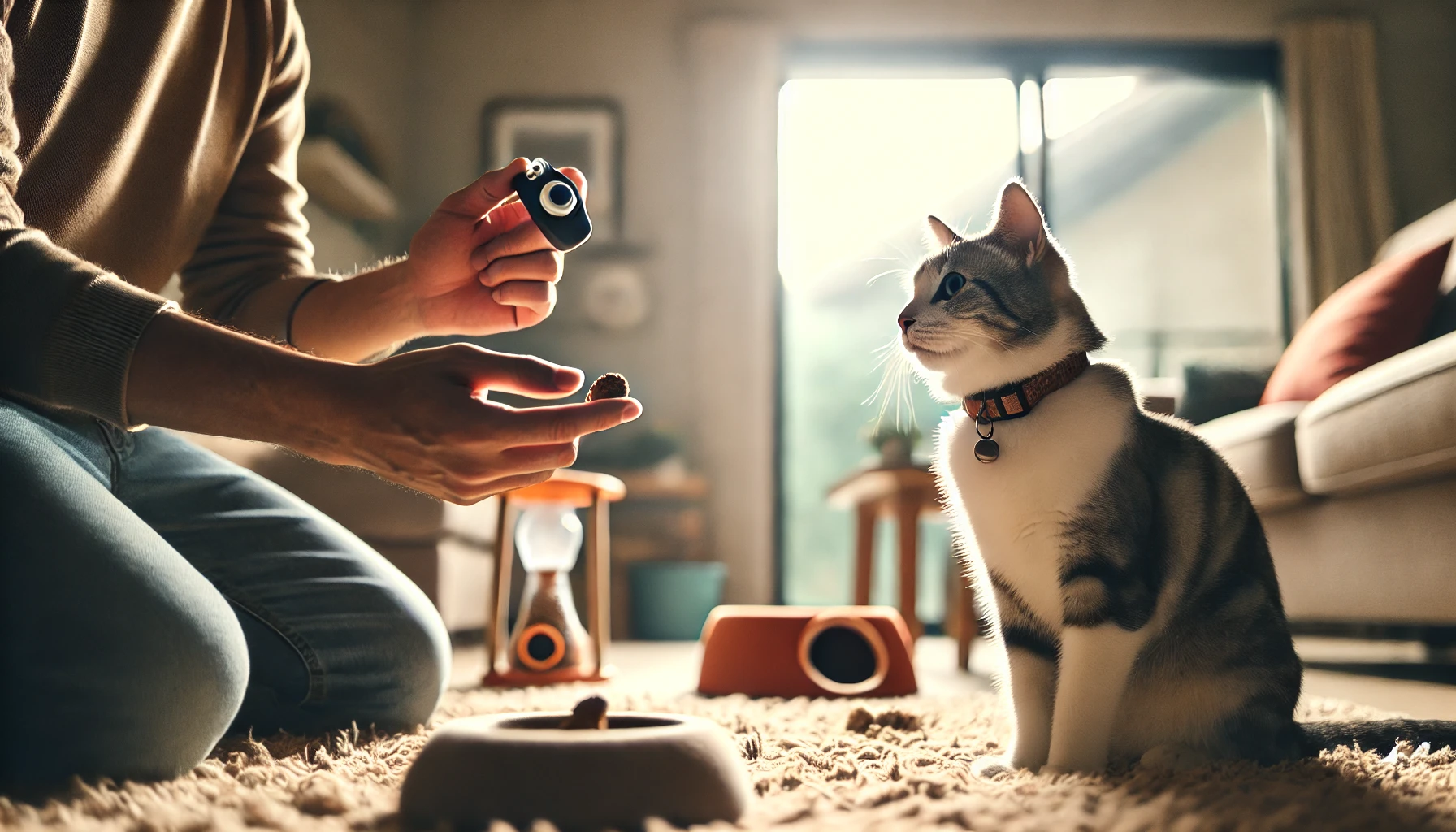
Step-by-Step Guide for Getting Started with Clicker Training
Now that you have your tools and environment ready, it’s time to start clicker training your cat.
Clicker training is all about being consistent, timing correctly, and having plenty of patience.
Cats can be extremely independent and sometimes very stubborn, so it’s important to start slow and work at modifying your cat’s natural behavior.
The following is a step-by-step guide to get you moving in the right direction.
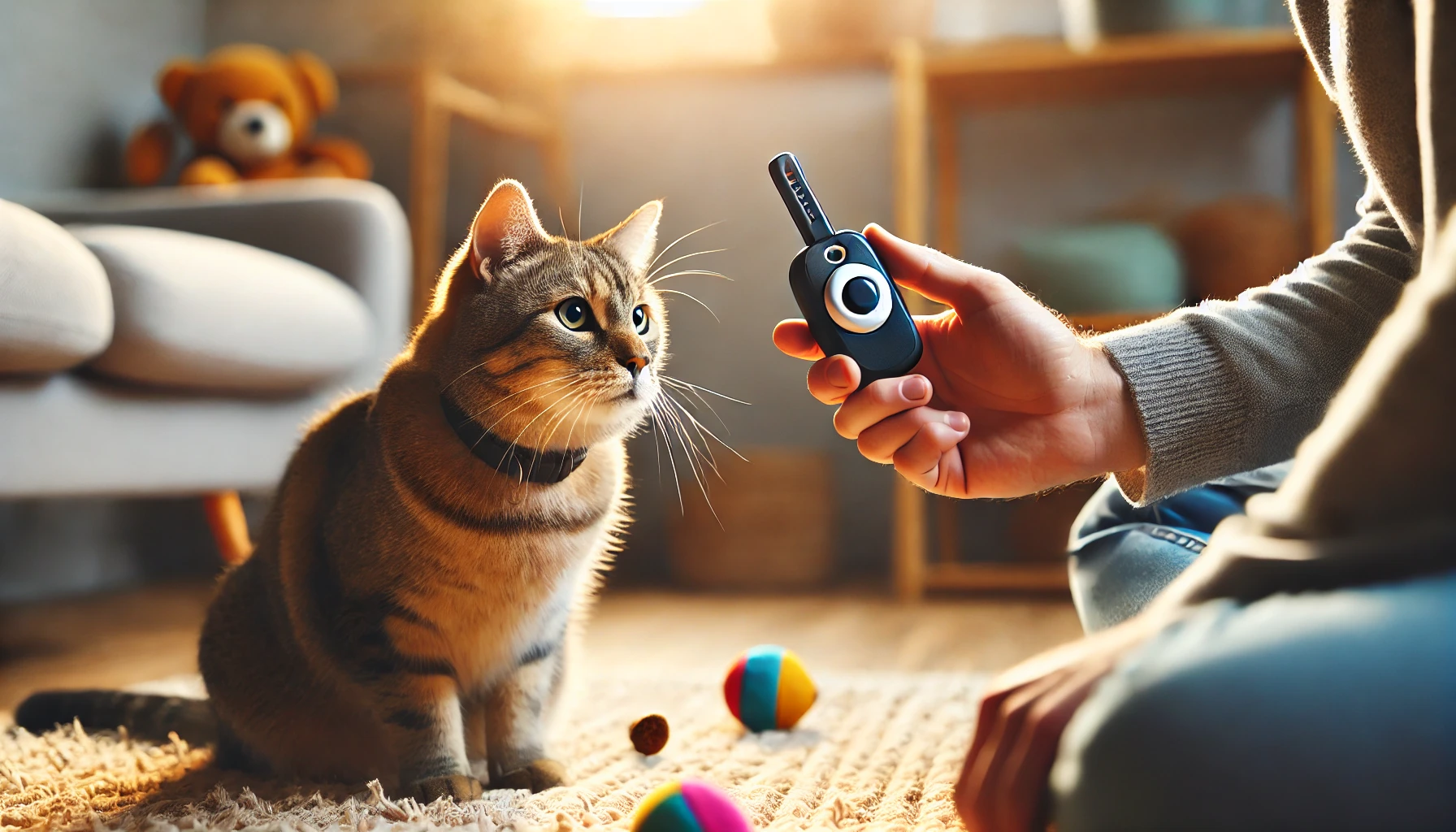
Introducing Your Cat to the Clicker
In clicker training, the first step is to help your cat understand what the clicker means.
Essentially, you need to condition your cat to associate the sound of the click with a reward.
Follow these simple steps:
- Step 1: Hold the clicker in one hand and some treats in the other.
- Step 2: Click the device once and immediately give your cat a treat. Make sure there is no delay between the click and the treat.
- Step 3: Repeat this process several times. After a few repetitions, your cat will begin to associate the clicking sound with receiving a treat.
This is called ‘charging the clicker’ and is an essential step for your cat to learn that the click sound means a reward.
Do this in several short sessions over the course of a few days before moving on to actual commands.
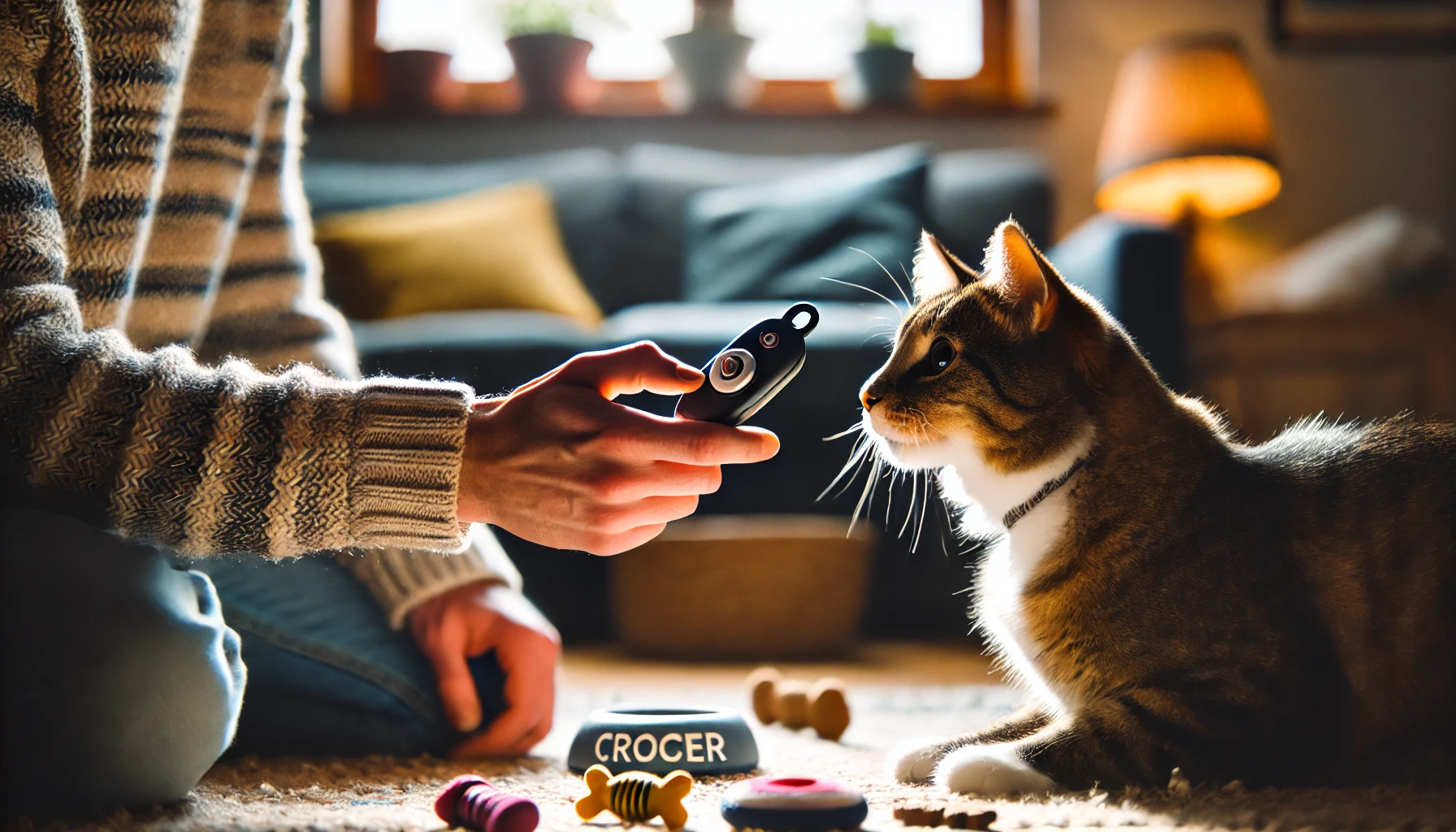
Pair the Clicker with Positive Reinforcement
Once your cat has learned what the clicker means, it’s time to use it for positive reinforcement.
The idea is to reward behaviors you want your cat to repeat.
Whether it’s getting your cat to sit or come when called, you’ll use the clicker to mark these actions.
- Step 1: Wait for your cat to naturally perform an action, such as sitting or touching your hand.
- Step 2: As soon as your cat performs the desired action, click the tool and immediately give them a treat.
- Step 3: Over time, your cat will associate the action with the click and the treat, encouraging them to repeat the action.
Be consistent.
Click at the exact moment your cat performs the behavior, and reward them immediately afterward.
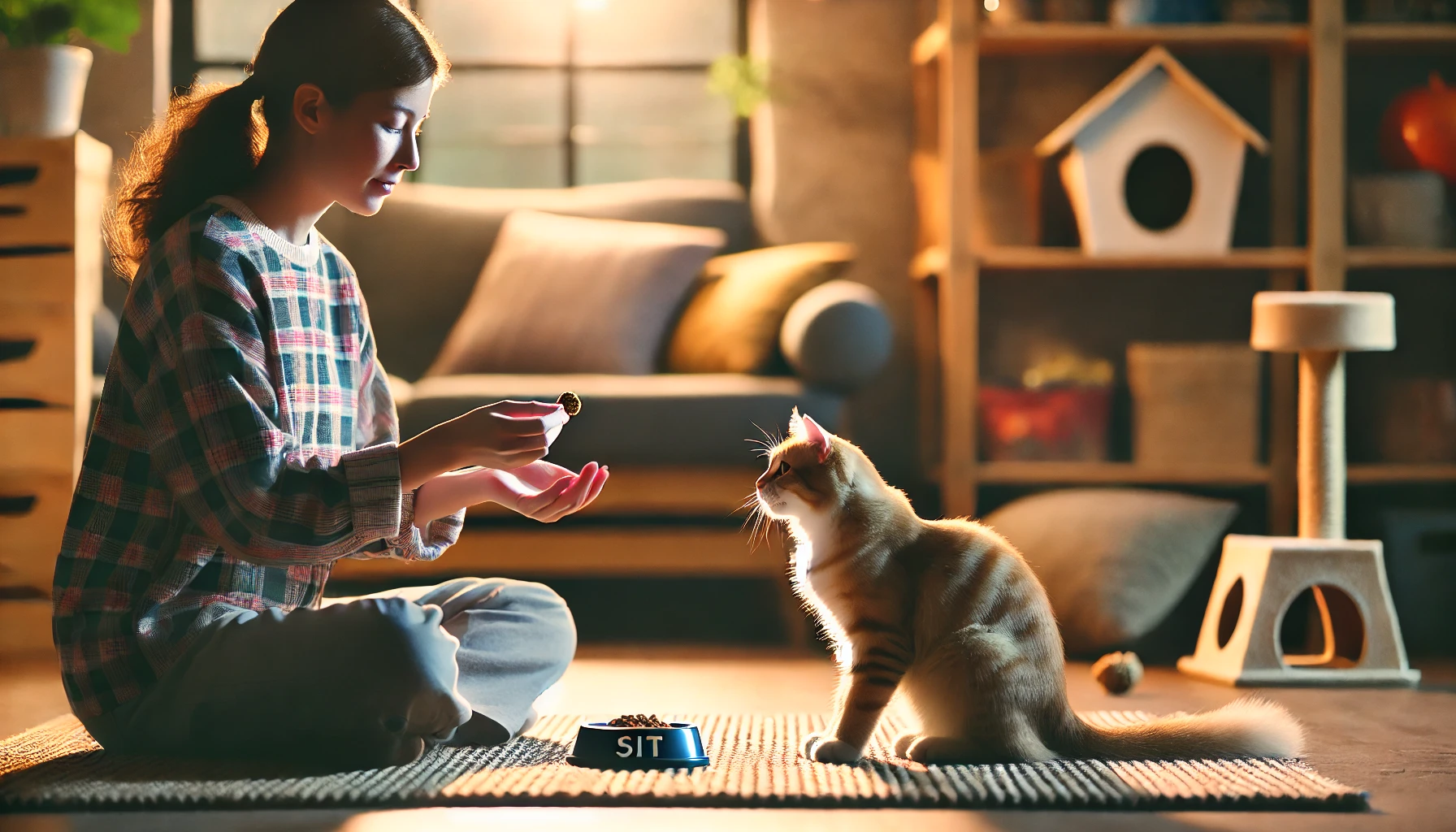
Clicker Training Basic Commands
Once your cat has become familiar with the clicker, you can begin teaching basic commands.
Here are some common commands to start with:
- Sit – Wait for your cat to sit naturally. Click and reward them. After several repetitions, your cat will begin sitting on command with the use of a verbal cue and the clicker.
- Come – Hold a treat and call your cat’s name. As soon as they come to you, click and treat. Over time, your cat will come when called, even without seeing the treat.
- High-Five – Lightly tap your cat’s paw and wait for them to raise it. As soon as they do, click and reward them. Repeat this until your cat understands the high-five command.
These basic commands form an excellent foundation for clicker training, and once mastered, you can move on to teaching more advanced tricks and behaviors.
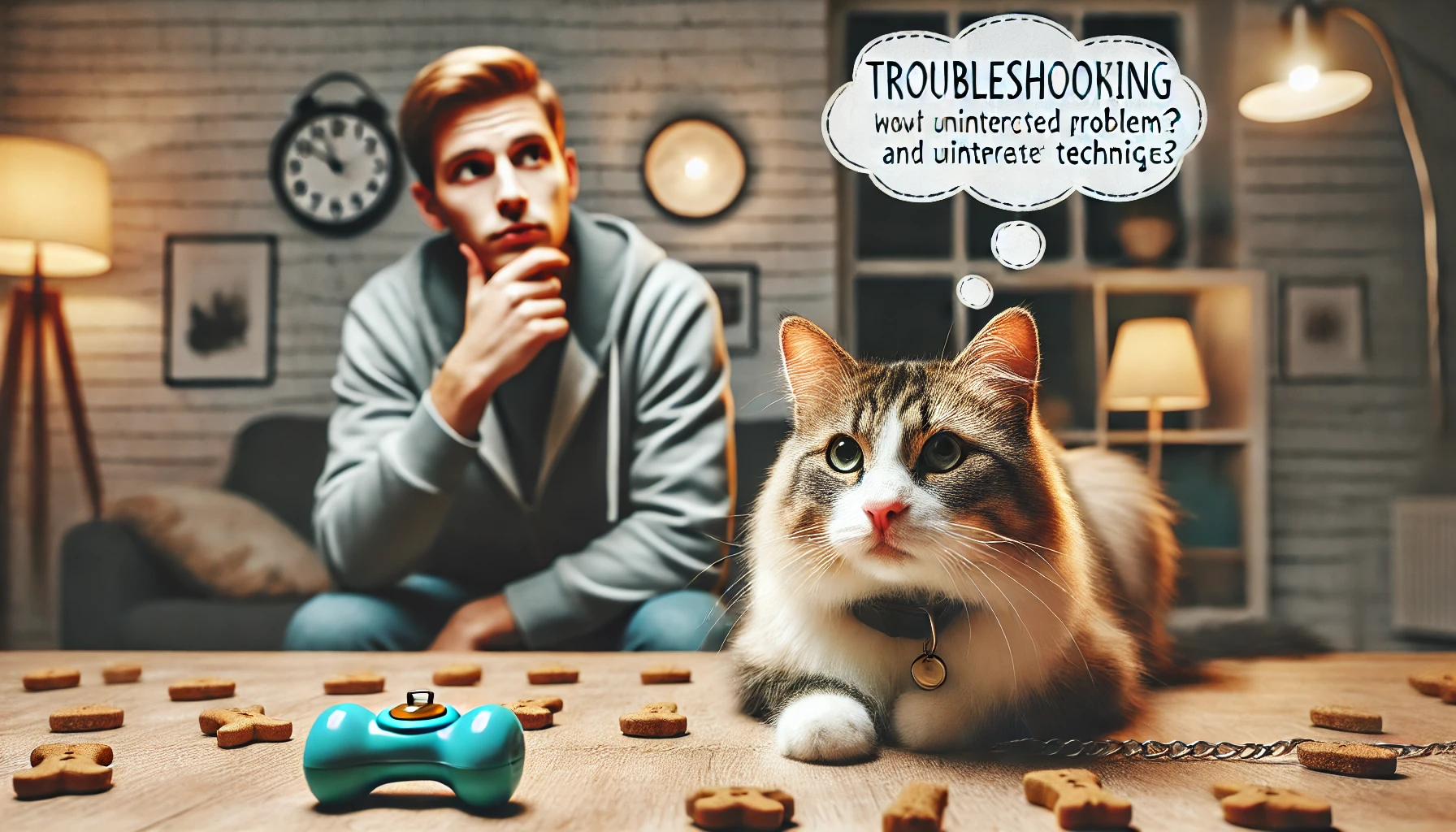
Common Problems and Troubleshooting
Clicker training is not without its challenges.
Some cats pick up on it more slowly than others, and some may not respond to the clicker at first.
If you encounter any issues, consider the following:
- Your cat doesn’t react to the clicker: Make sure you’re clicking at the right moment and rewarding immediately after. Timing is everything in clicker training.
- Your cat is easily distracted: Ensure you’re training in a quiet, distraction-free area. If your cat seems bored or uninterested, shorten the sessions or use higher-value treats.
- Your cat seems anxious or stressed: Some cats may become anxious if they don’t understand what’s expected of them. Be patient, and never punish your cat for not responding. Clicker training should always be a positive experience.
With time and persistence, your cat will begin to respond to clicker training.
The right way to ensure your cat learns and enjoys the process is through patience and consistency.
Introducing your cat to the clicker takes time, patience, and repetition to build the correct association.

Advanced Clicker Training Techniques for Cats
Now that your cat has mastered the basic elements of clicker training, it’s time to try more advanced techniques.
These advanced techniques will help you teach complicated behaviors, curb unwanted habits, and even explore new ways to use the clicker to communicate with your cat.
As in basic training, consistency and positive reinforcement are crucial to success.
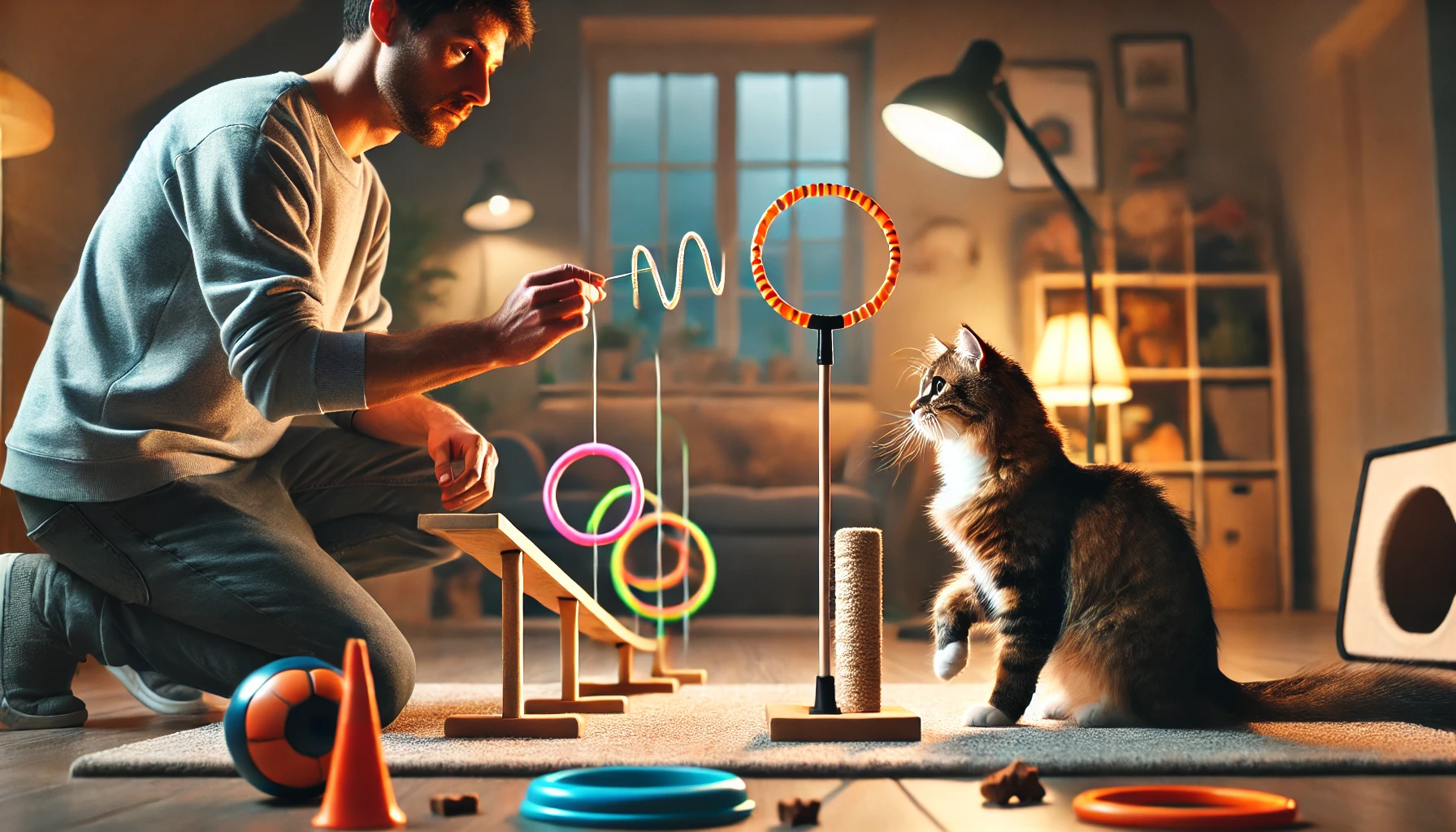
Clicker Training Complex Behaviors
Clicker training is an excellent tool for teaching complex behaviors.
Once your cat has mastered simple commands, you can build on that foundation to teach more advanced techniques and involved tricks.
A useful technique for teaching complex behaviors is called ‘shaping.’ Shaping is the process of breaking down a behavior into smaller steps that are easy for your cat to learn.
Here’s how you can apply this technique:
- Identify the final behavior – Choose the complex behavior you’d like your cat to perform, such as jumping through a hoop or playing fetch.
- Break it down into steps – Divide the behavior into smaller, incremental actions. For example, if you want your cat to jump through a hoop, start by rewarding them for walking near the hoop.
- Click and reward each step – Reward each small success, gradually increasing the difficulty until your cat can perform the entire behavior.
- Use a target stick – For more difficult behaviors, a target stick can help guide your cat by encouraging them to follow or touch it as part of the training.
Shaping allows your cat to progress at their own pace.
With patience, you’ll be able to teach behaviors that may seem tricky at first.
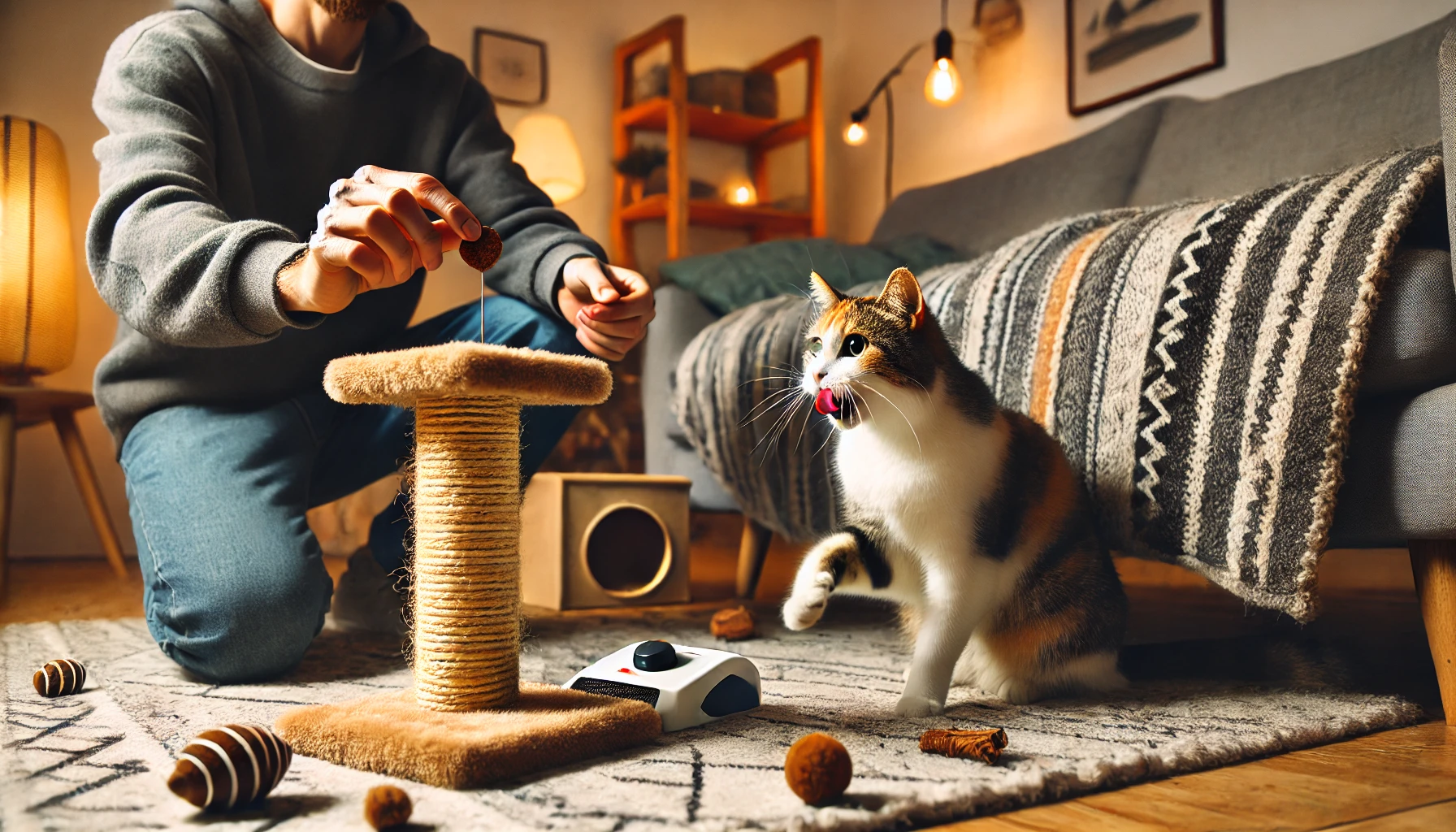
Using Clicker Training to Curb Unwanted Behaviors
In addition to teaching tricks, clicker training is a great method for curbing unwanted behaviors.
Cats may scratch furniture, bite, or jump onto countertops, but with clicker training, you can redirect these behaviors to more appropriate alternatives.
Here’s how you can manage unwanted behaviors:
- Redirect the behavior – If your cat is engaging in unwanted behavior, like scratching the couch, wait until they stop and immediately offer an alternative, such as a scratching post. The moment they engage with the alternative, click and reward.
- Reinforce positive behaviors – For example, reward your cat when they use the scratching post instead of the couch.
- Be consistent – Consistency is key when trying to eliminate undesirable behaviors. Click and reward every time your cat chooses the desired behavior over the unwanted one.
By consistently rewarding positive alternatives, you can help your cat replace unwanted behaviors with more acceptable ones.
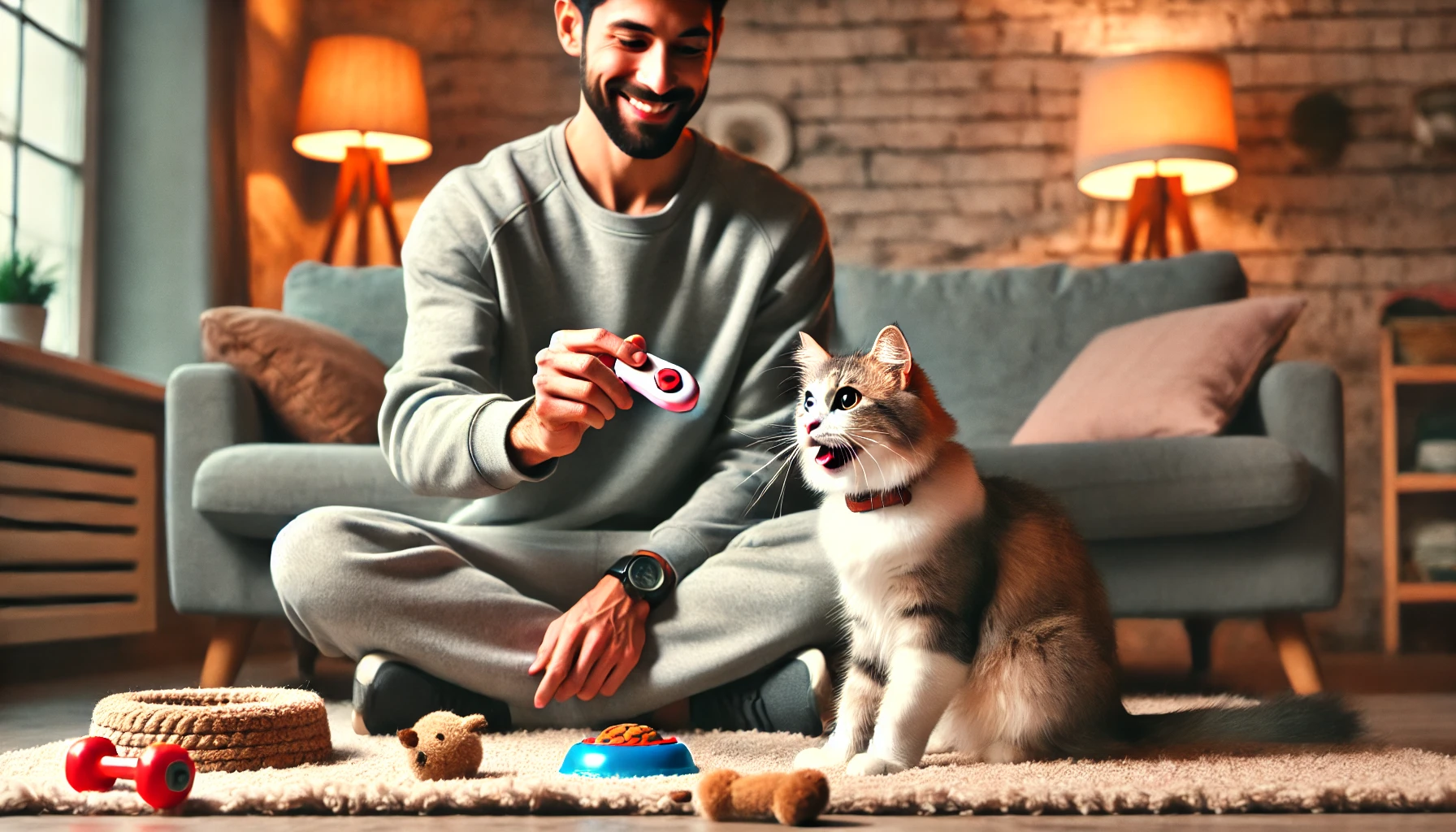
Transitioning from Treats to Other Rewards
As your cat becomes more comfortable with clicker training, you may want to reduce your reliance on treats.
While treats are highly effective for reinforcing behaviors in the early stages, you can gradually transition to other rewards like affection or playtime.
Here’s how to do it:
- Start mixing rewards – Occasionally replace treats with verbal praise, petting, or a favorite toy. Continue using the clicker to signal correct behavior, but alternate the reward type.
- Reduce the number of treats – Gradually decrease the number of treats you offer, while still reinforcing the behavior with the clicker.
- Use play as a reward – For playful cats, use a favorite toy or interactive game as a reward instead of food treats.
Transitioning to non-food rewards keeps training sessions fun and engaging, without relying solely on treats.
These advanced techniques not only expand your cat’s abilities beyond basic commands, but they also help strengthen the bond between you and your cat.
Clicker training becomes a valuable tool for communication, learning new tricks, and building trust with your feline friend.
Advanced techniques like shaping allow you to teach complex behaviors by breaking them into small, manageable steps.

Maintaining Long-Term Success with Clicker Training
Clicker training is not something that stops once your cat has learned a few tricks or basic commands.
For long-term success, and to keep your cat interested, it’s essential to continue practicing and reinforcing those behaviors.
Like any form of training, consistency plays an important role in making clicker training a permanent part of your cat’s routine.
Here’s how you can establish a routine for continued progress, keep your cat motivated, and adapt training as your cat grows and matures.
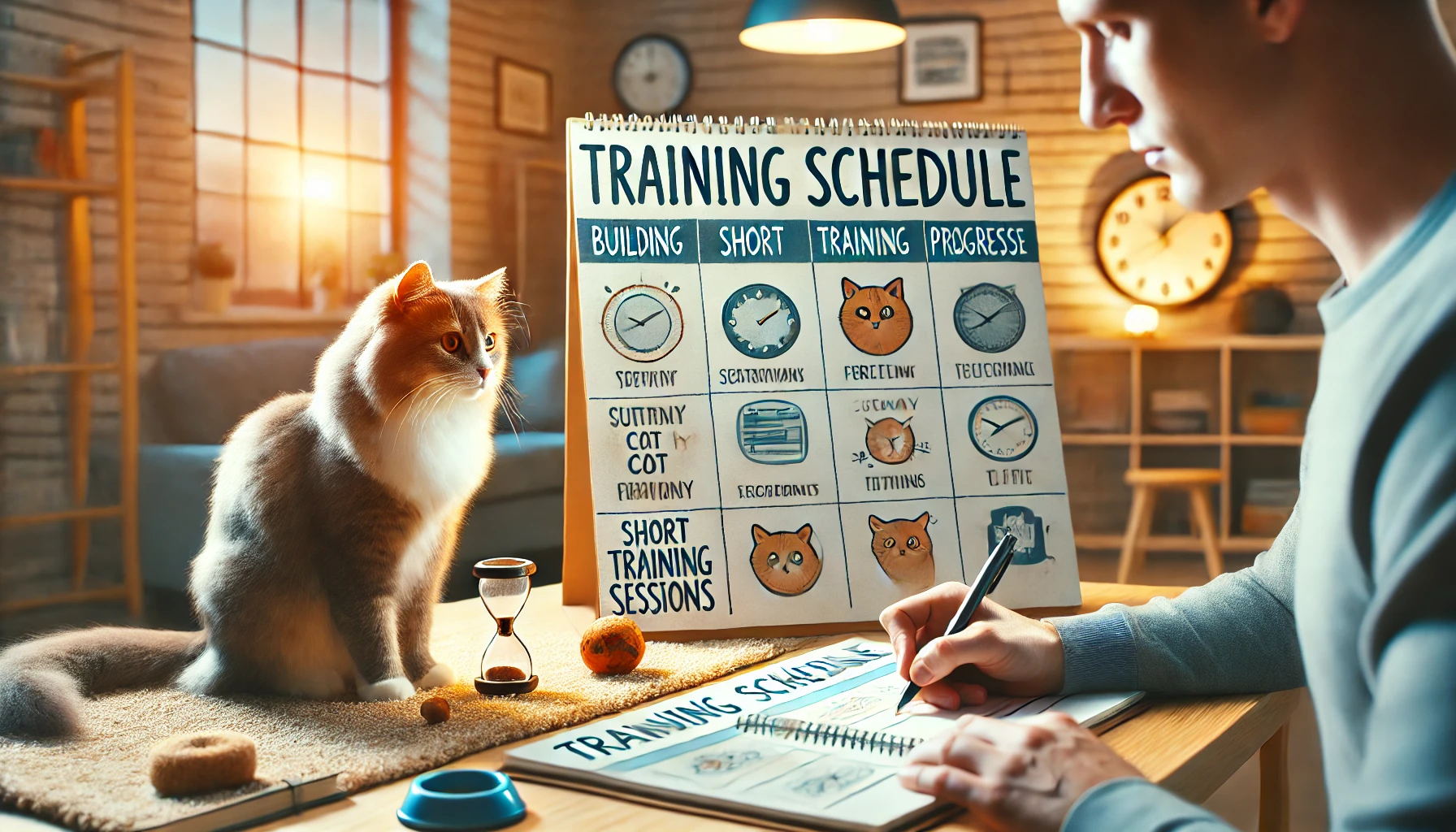
Building a Routine for Continued Progress
Once your cat has mastered the basics of clicker training, it’s important to maintain a schedule where they can practice previously learned behaviors and gradually learn new ones.
Here’s how you can build an effective routine:
- Short, frequent sessions – Short training sessions, around 5-10 minutes, are ideal, but practice daily. These short, daily sessions help keep your cat’s skills sharp without overwhelming them.
- Variety in commands – Once your cat has learned a few behaviors, mix up the commands during each session to add variety. This helps prevent your cat from becoming bored with repetitive tricks.
- Gradually add challenges – As your cat becomes confident with certain behaviors, gradually introduce new challenges or combine commands to keep them engaged and learning new skills.
By maintaining a routine, you’ll keep your cat sharp with their clicker training, while also introducing new skills and keeping their experience enjoyable.

Staying Consistent and Positive
Consistency is one of the most important factors in successful clicker training.
Cats learn best when the training is positive and predictable, so it’s crucial to be consistent in your methods:
- Click at the right moment – Timing is everything. Always click at the precise moment your cat performs the desired behavior, and immediately follow up with a reward.
- Use positive reinforcement – Avoid punishments or negative reinforcement. Cats learn best when rewarded for good behavior, rather than penalized for mistakes.
- Be patient – Some behaviors may take longer to learn than others. Be patient and allow your cat to progress at their own pace.
By staying consistent and positive, you’ll reinforce the good behaviors you’ve taught and continue to build trust between you and your cat.

Adapting Clicker Training as Your Cat Matures
As your cat gets older, their needs and interests will naturally change, which means you may need to adjust your approach to clicker training.
Here’s how to modify training as your cat matures:
- Introduce age-appropriate behaviors – Younger cats tend to be more playful and energetic, while older cats may prefer gentler activities. Tailor your training sessions to suit your cat’s age and energy levels.
- Change rewards as preferences shift – As your cat grows, their preferences for rewards may change. Some cats may become less food-motivated over time, so use toys, affection, or play as alternative rewards.
- Monitor your cat’s physical abilities – Older cats may develop physical limitations that affect their ability to perform certain behaviors. Be mindful of your cat’s health and adjust the training to accommodate any limitations.
By adapting clicker training to meet your cat’s changing needs, you’ll be able to continue using this method effectively throughout their life.
Long-term success with clicker training requires consistency, patience, and adaptability.
By regularly practicing, reinforcing positive behavior, and adjusting to your cat’s evolving needs, clicker training will remain an enjoyable and effective tool for communication and learning.
Whether reinforcing old behaviors or teaching new ones, clicker training can strengthen your relationship with your feline friend over time.
Consistency and patience are essential for maintaining long-term success and keeping your cat engaged in clicker training.

Clicker Training: How to Achieve Long-Term Success with Your Cat
Clicker training is an amazing way to communicate with your cat.
Through clicker training, you can teach your cat various tricks and transform undesirable behaviors into positive ones.
Whether you’re teaching the basics, complex tricks, or breaking bad habits, the principles of clicker training provide a non-violent way to strengthen the bond between you and your feline friend.
In this conclusion, we will summarize key points and insights that will help you on your journey toward mastering clicker training for cats.
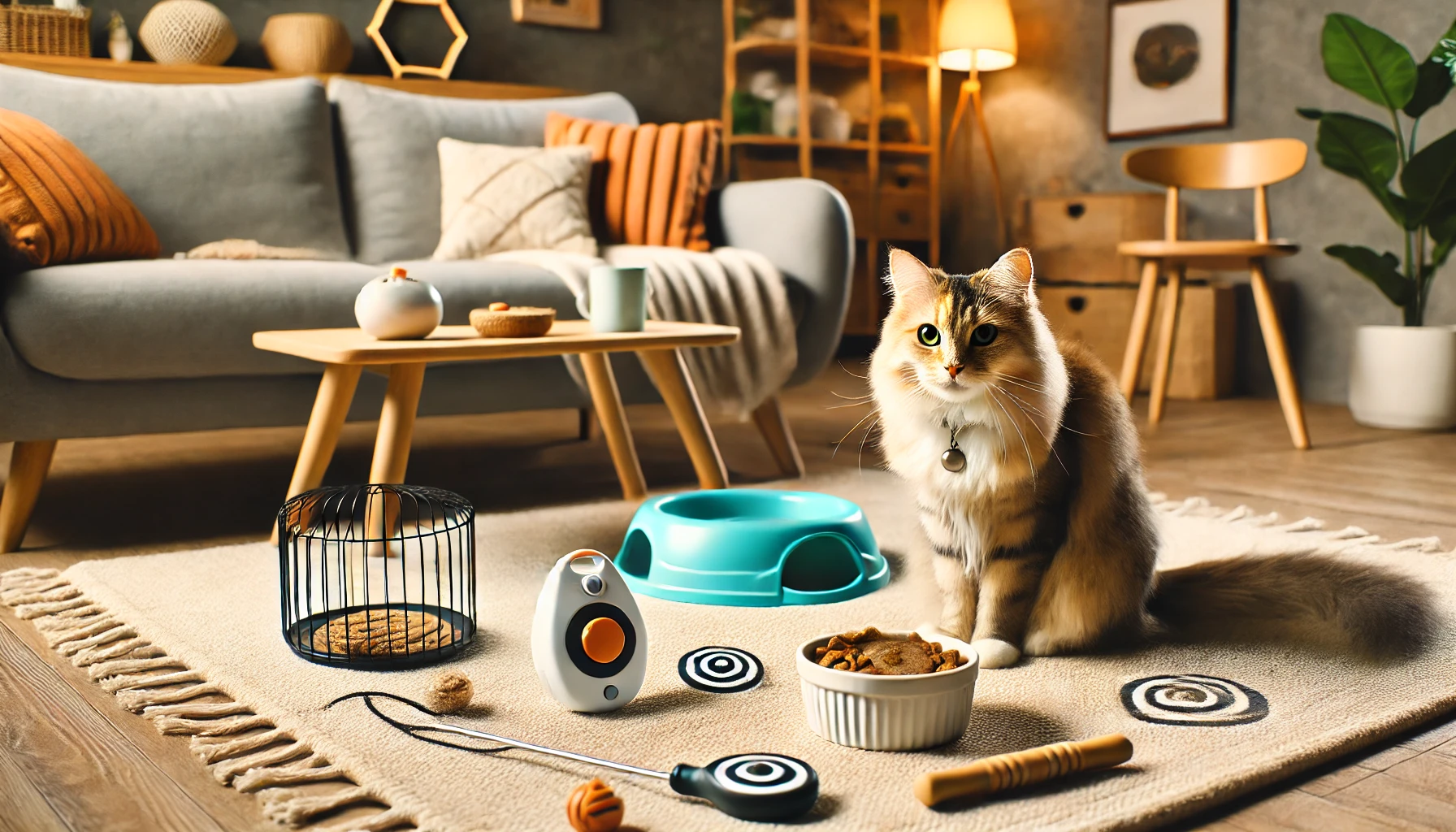
The Basics: Setting Up for Success
Clicker training starts with having the right tools and setting.
First, you need a clicker and some tasty treats.
It’s also important to train in a quiet, distraction-free environment where your cat can stay focused.
When the setting is right, your cat will feel relaxed and ready to learn.

Step-by-Step Progress: From Introduction to Complex Behaviors
Once your cat becomes familiar with the clicker, you can begin teaching simple commands like ‘sit’ and ‘come.’ Over time, with patience and consistency, you can build on this foundation to teach more complex behaviors.
Using the shaping technique—breaking behaviors into smaller, manageable steps—allows your cat to gain confidence as they master each new challenge.
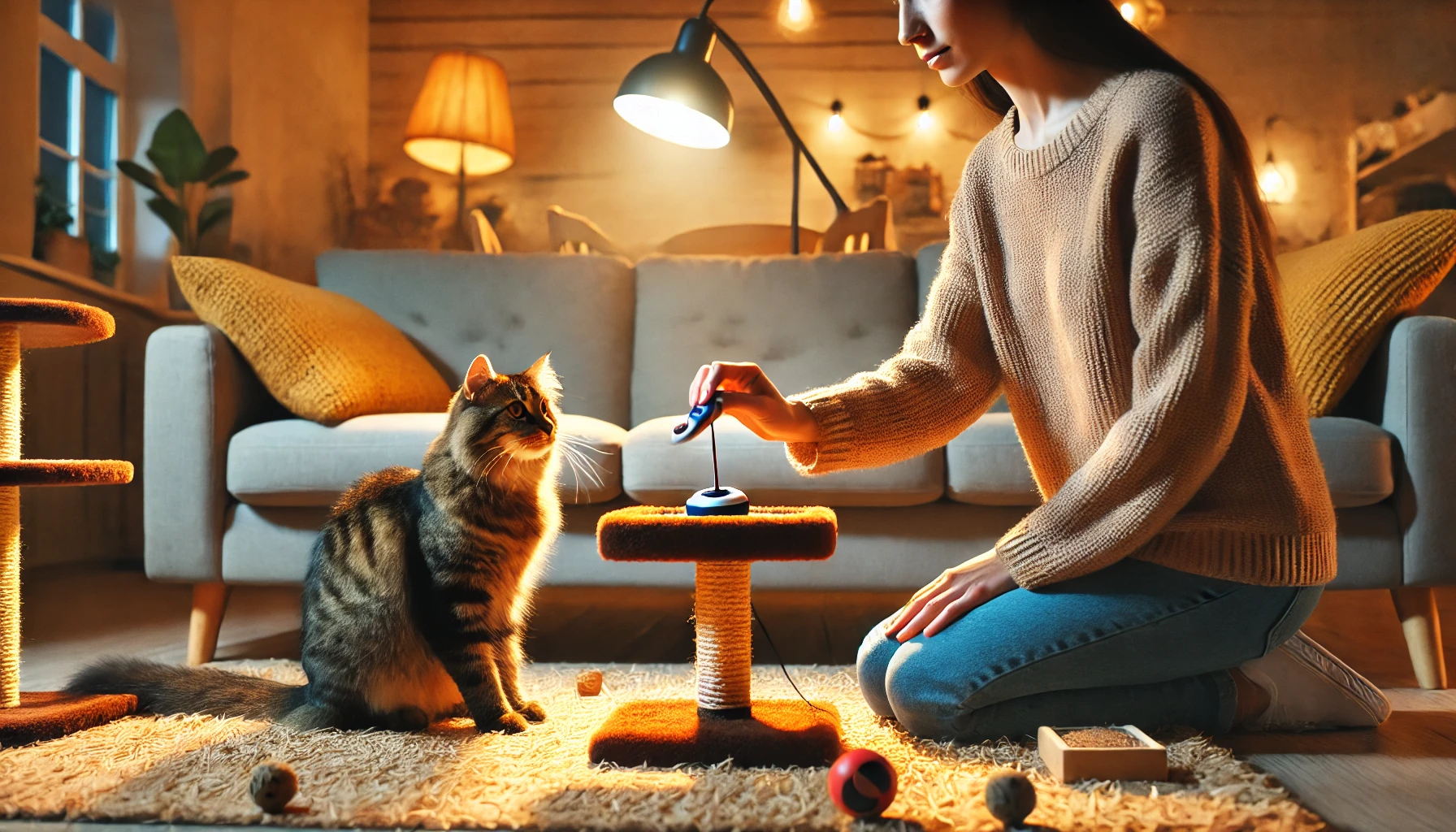
Using Clicker Training to Address Unwanted Behaviors
Clicker training isn’t just for tricks; it’s also a powerful tool for addressing unwanted behaviors like scratching furniture or jumping onto counters.
By using positive reinforcement and consistency, you can guide your cat toward more acceptable behaviors, rewarding positive alternatives and replacing bad habits with good ones.
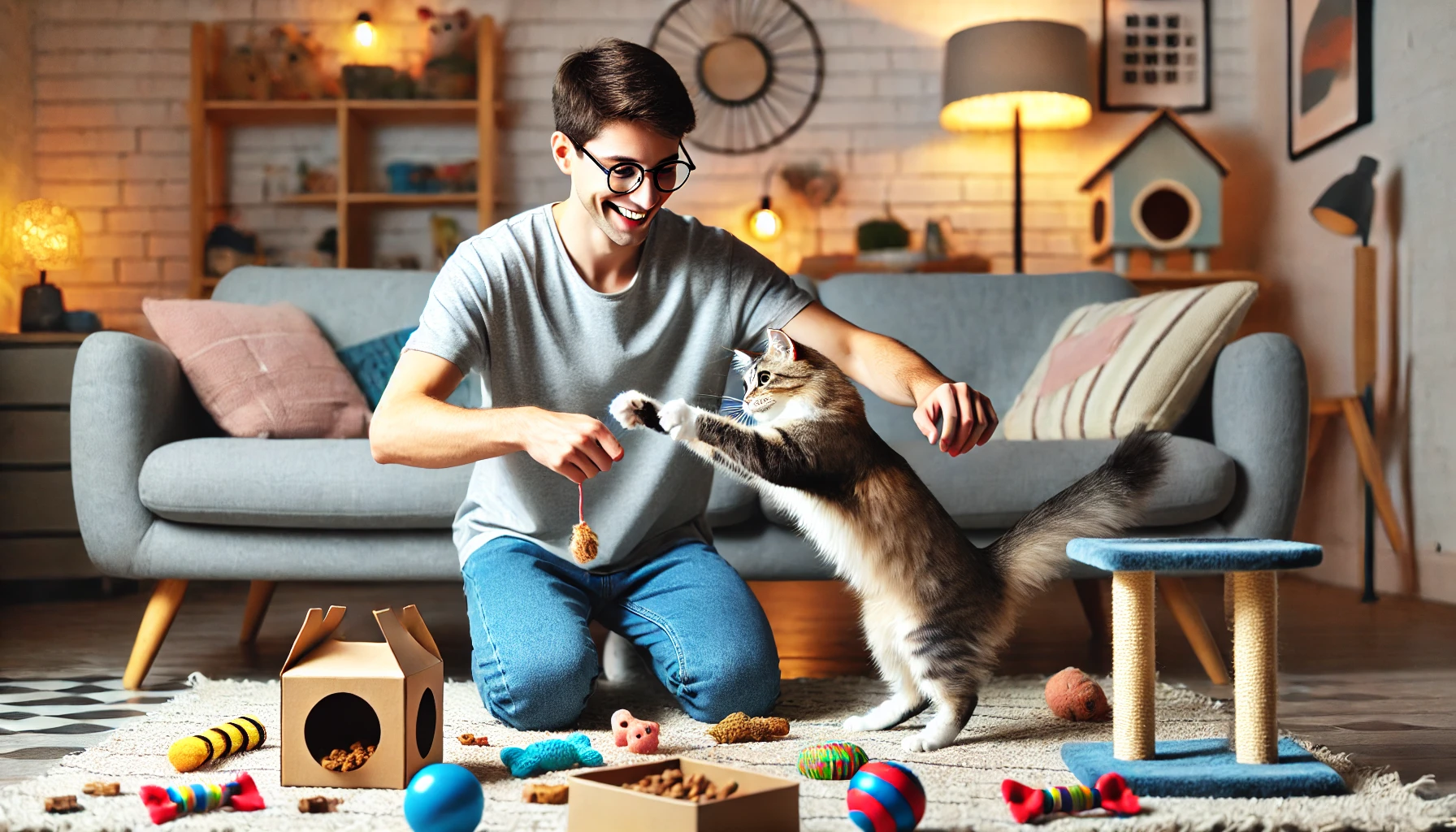
Maintaining Engagement and Motivation
To ensure long-term success with clicker training, it’s important to keep your cat motivated.
Regular practice, short but frequent sessions, and mixing up commands can help prevent boredom.
Additionally, transitioning from treat-based rewards to other forms of motivation, like play, affection, or verbal praise, can keep your cat engaged without relying solely on treats.
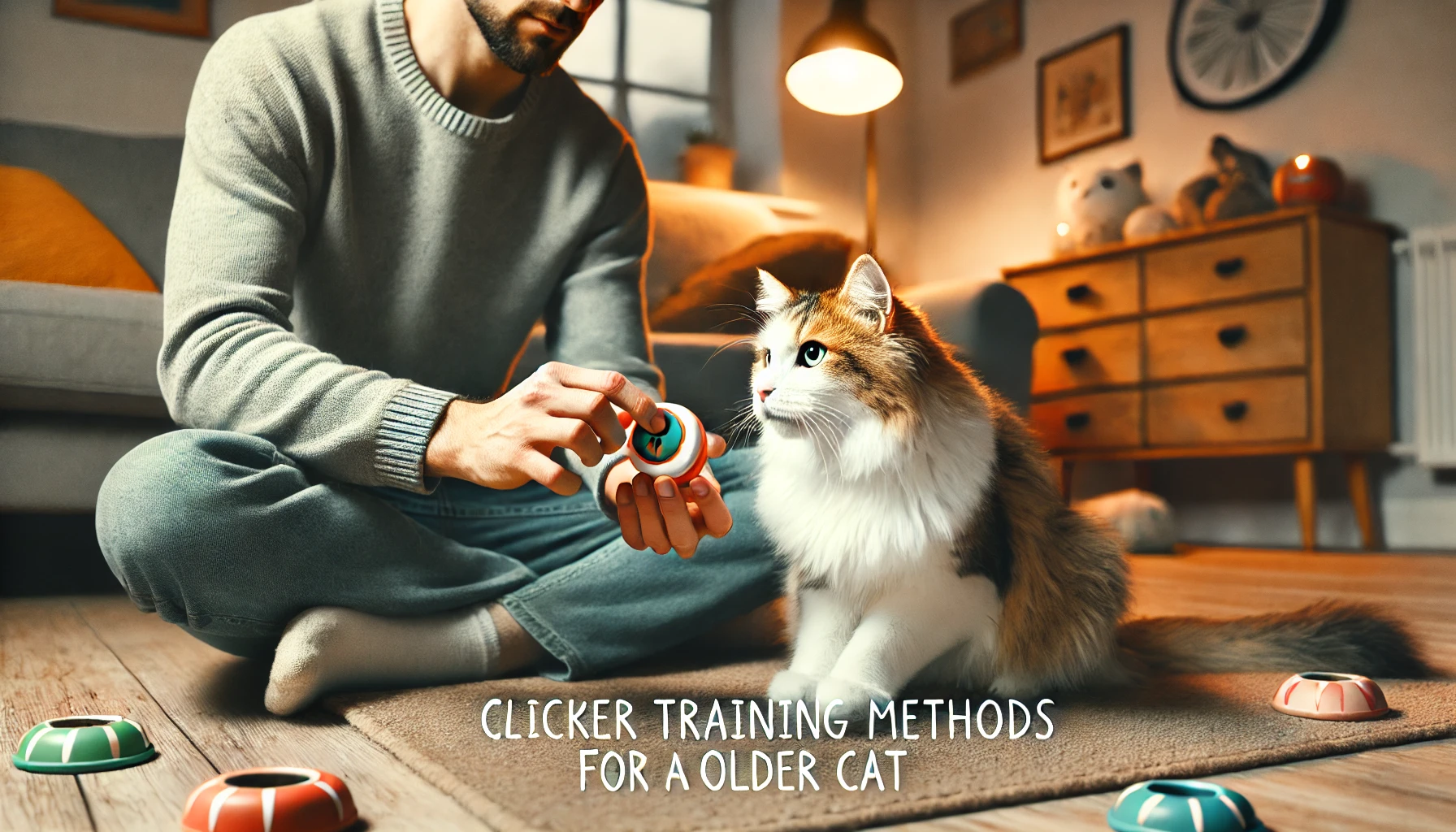
Adapting Clicker Training Over Time
As your cat ages, their needs and abilities will change.
Adjusting your training routine accordingly helps maintain their interest and ensures that clicker training remains effective.
Paying attention to your cat’s health and adapting the training to their physical capabilities will keep them motivated and engaged.

Conclusion: Clicker Training – A Way to Build a Lifelong Bond
Clicker training is more than just a way to teach tricks—it’s a method for building a deep, trusting relationship with your cat.
By using positive reinforcement, staying consistent, and adapting the training to your cat’s needs, you can create a lasting bond based on communication and mutual understanding.
Whether you’re reinforcing old behaviors or teaching new ones, clicker training is a lifelong journey that will keep your cat engaged, happy, and well-behaved.
By following the techniques and principles outlined in this article, you’ll be well on your way to successfully clicker training your feline friend and making the most of this highly effective training method for both you and your cat.
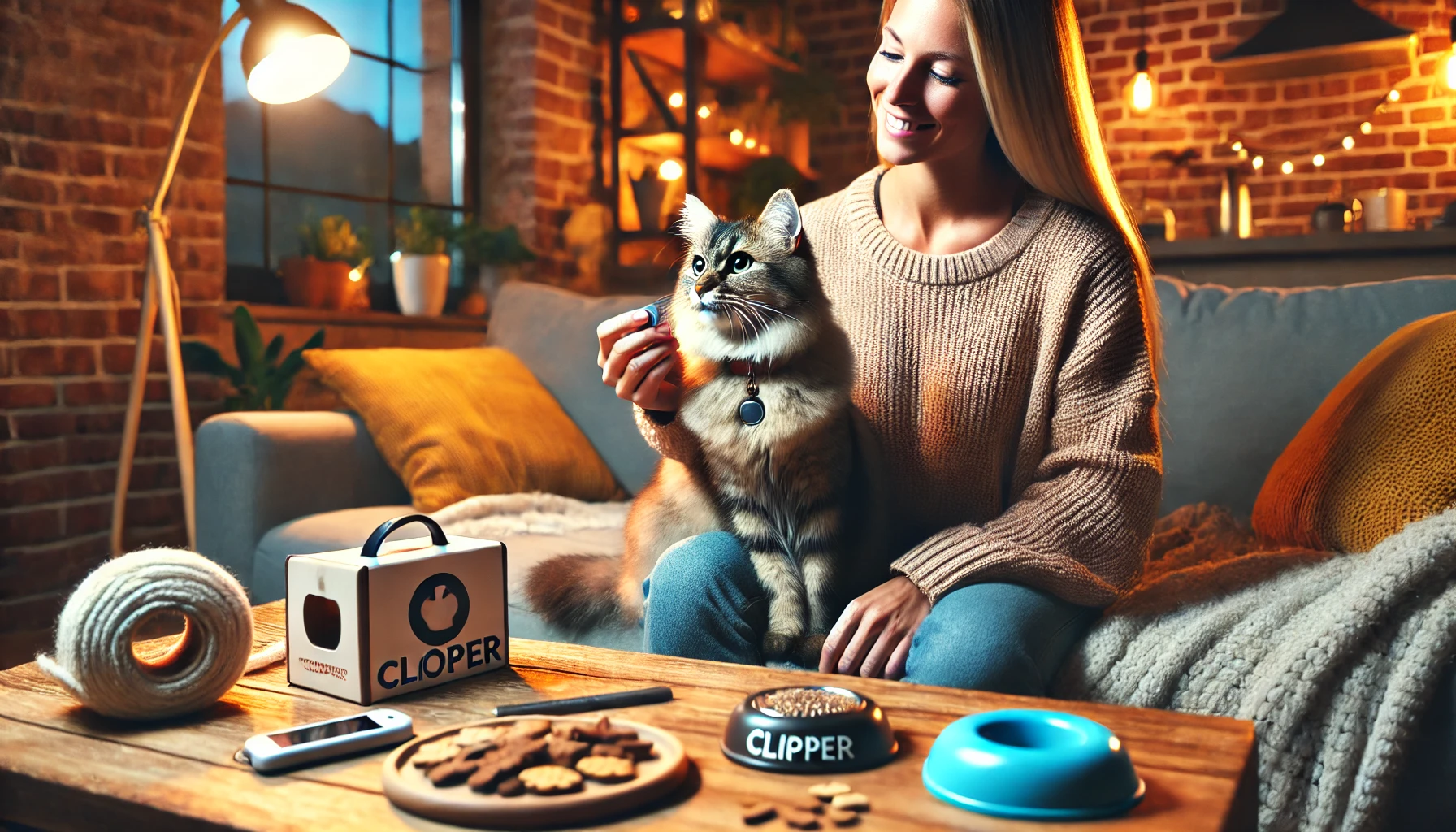
FAQs on Clicker Training for Cats
Here are some common questions that cat owners have about clicker training.
These answers will help you understand the process and ensure successful clicker training with your cat.
What is clicker training for cats?
Clicker training involves using a device that produces a sound to mark desired behaviors.
These behaviors are then rewarded with treats or affection, helping cats associate actions with positive outcomes.
How long does it take to clicker train a cat?
It varies, but most cats can start responding within a few days.
Consistency and short daily sessions can help them learn new behaviors within a couple of weeks.
Can you clicker train older cats?
Yes, you can clicker train older cats.
While they may learn more slowly than younger cats, with patience and consistent training, they can adopt new behaviors.
What if my cat does not respond to the clicker?
If your cat isn’t responding, check your timing to ensure the click is followed immediately by a reward.
You can also try using higher-value treats or minimize distractions to help your cat focus.
Is it necessary to use treats every time during clicker training?
Treats are essential at first to reinforce behaviors, but over time, you can switch to other rewards like affection, play, or praise to keep your cat motivated.
How long should clicker training sessions last?
Keep sessions short, around 5-10 minutes, to avoid overwhelming your cat.
Frequent, short sessions help reinforce behaviors and prevent boredom.
Can clicker training eliminate unwanted behavior?
Yes, clicker training can address unwanted behaviors like scratching furniture or jumping on counters by reinforcing positive alternatives and replacing bad habits with good ones.
Can multiple cats be clicker trained simultaneously?
It’s best to clicker train cats individually to avoid confusion.
Once each cat has learned the basics, you can gradually introduce group sessions, but individual training ensures clarity.
Is clicker training safe for all cats?
Yes, clicker training is a safe, non-violent method that uses positive reinforcement.
It’s suitable for cats of all ages and temperaments without causing stress or harm.


